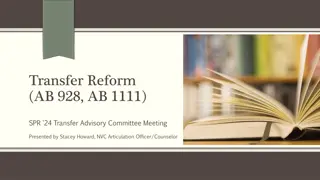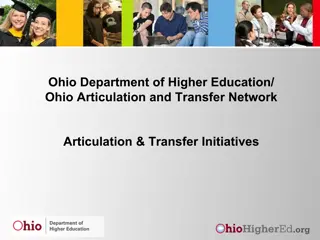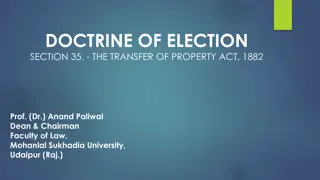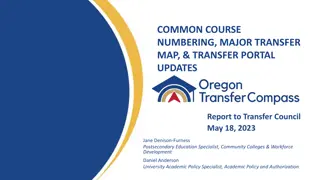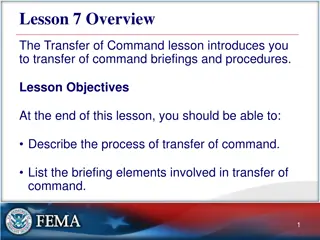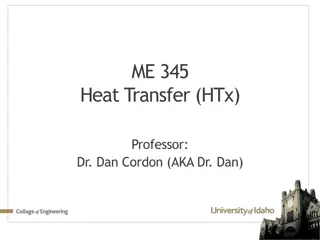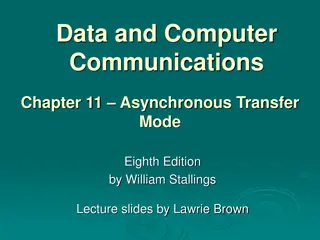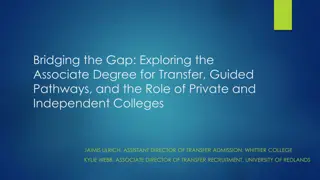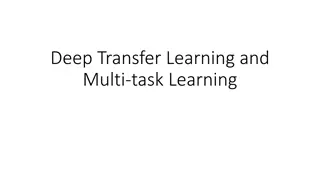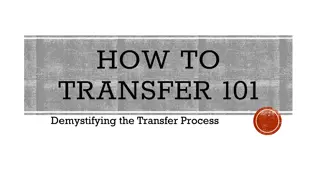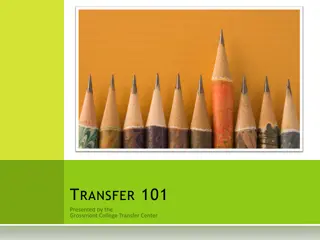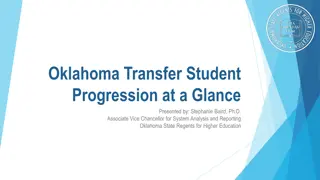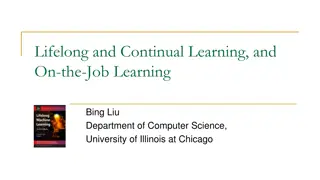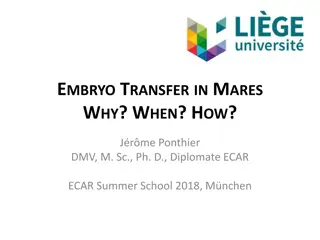Understanding Transfer of Learning in Education
Transfer of learning occurs when prior knowledge, skills, and habits impact the learning or performance of new tasks. This process is influenced by factors such as similarity between tasks, known as the Theory of Identical Elements. Various definitions by researchers highlight the significance of applying acquired knowledge in different contexts, fostering connections between learning experiences.
Download Presentation

Please find below an Image/Link to download the presentation.
The content on the website is provided AS IS for your information and personal use only. It may not be sold, licensed, or shared on other websites without obtaining consent from the author. Download presentation by click this link. If you encounter any issues during the download, it is possible that the publisher has removed the file from their server.
E N D
Presentation Transcript
TRANSFER OF LEARNING Presented By: Priyanka Maurya, Assistant Professor, Department of Education (M.Ed.), C.S.J.M. University, Kanpur. Email: priyanka@csjmu.ac.in
CONTENT: INTRODUCTION- TRANSFER OF LEARNING TYPES OF TRANSFER THEORIES OF TRANSFER OF LEARNING FACTORS AFFECTING TRANFER OF LEARNING
INTRODUCTION: In our day to day life, we often notice that while learning new task there has always been an influence of previous learning on it. This influence can facilitate or hinders the new learning. For example: 1. If you know, how to ride bicycle, you can learn to drive scooty more easily.
2.Knowledge of mathematical concepts helps in better understanding of Physics subject. 3.One who is driving an auto-start motorcycle may find difficulty in driving kick-start motorcycle. The reason behind all this is a transfer of knowledge or skills from prior learning to new learning. This is referred to as Transfer of Learning .
The notion was originally introduced as transfer of practice by Edward Thorndike and Robert S. Woodworth.
Thorndike and Woodworth explored how individuals would transfer of learning in context to another context that shared similar characteristics. Their theory implied that transfer of learning depends on the proportion to which learning task and the transfer task are similar. This is known as Theory of Identical Elements.
DEFINITIONS: 1. According to Sorenson (1948), Transfer refers to the transfer of knowledge, training and habits acquired in one situation to another situation. 2.According to Blair, Jones & Simpson (1962), Transfer of learning exists whenever a previous learning has influence upon the learning or performance of new responses. 3. According to Perkins and Salomon (2012), Transfer of learning occurs when learning in one context or with one set of materials impacts on performance in another context or with other related materials.
CONCLUSION: Transfer of learning refers to the application of acquired knowledge, skills, habits and attitudes to situations different from those in which these were acquired by the learner. In simple words, it can be said that it involves the application of learning to new situations. Example: Application of mathematical concepts in solving numerical problems in Physics.
TYPES OF TRANSFER: Positive Transfer: It happens when learning in one situation facilitates learning and performance in another situation. Example: Driving a scooter facilitates driving a motorbike. Negative Transfer: It happens when learning in a previous situation interferes with, or inhibits learning in a new situation. Example: left hand drive vehicles hindering the learning of right-hand drive.
Neutral or Zero Transfer: When learning in one situation does not have any significant influence over the learning in another situation. Example: knowledge of history in no way affects learning of driving a car or scooter. Lateral Transfer: It happens when learning in one context is employed at the same level in new context. Example: Writing letters at school can be applied to write letters of various types like- Official letters, friendly letter or invitation letter for the student s personal use.
Vertical transfer: It happens when learning at one level facilitates at a higher level. Example: If a child learns that when zero is multiplied by any number, the result will be zero.After learning this if s/he solved the problem like- 142.056 * 521/21*0=0 Then this is the example of vertical transfer of learning. Bilateral Transfer: It refers to the case in which training imparted to one limb of the body transfer itself to the parallel limb on the other side. Example: After being trained in writing or working with the right hand, children learn to write or perform the same activity with the left hand without any additional practice.
Schunk define types of transfer as follows: Near Transfer: It occurs when many elements overlap between the conditions in which the learner obtained the knowledge or skill and the new situation. Example: A student who learns to type on a typewriter applies that knowledge to a computer keyboard. Far Transfer: It occurs when the new situation is very different from that in which learning occurred. Example: A student applies what he has learned in trigonometry class while doing a practicum in architect s firm.
Saloman and Perkins (1989) define two types of transfer as follow: Low road transfer: It takes place when the initial learning task and the transfer task are so similar that the learner automatically applies his initial learning to the transfer task. Example: When a competent reader encounters new sentences in their native language, they read them automatically. High road transfer: This transfer occurs when the initial learning task and transfer task are different enough that the learner has to do some thinking and make a conscious effort to apply his initial learning to the transfer task. Example: Selecting and using a statistical test with new and different kind of data.
Theories of Transfer of Learning Theory of Mental Discipline Theory of Identical Elements Theory of Generalization Theory of Configuration
Theory of Mental Discipline This theory states the various faculties of the mind can be developed through proper training in the same way as muscles developed through physical exercise. These faculties can be developed through learning of specific subjects. Example: reasoning power can be developed by learning mathematics.
Theory of Identical Elements This theory was propounded by Thorndike. According to him the amount of transfer depends upon the identical items in both situations. Here identical elements can be content, method, aim or attitude present in both learning situations.
Theory of Generalization This theory was formulated by Charles H. Judd. He stated that transfer is a form of generalization which can be encouraged by training. This theory give emphasis on value to understand, organize and generalize specific experiences.
Theory of Configuration This theory is based on Gestalt theory of learning. Transfer implies that what is learned in one situation can be shifted to another situation only when similarity of the two learning situations is perceived by the learner.
FACTORS AFFECTING TRANFER OF LEARNING Similarities between two learning situations. Ability of learner. Degree of meaningfulness/ relevance of learning Length of instructional time.
Variety of learning experiences. Context for learner s experience. Focus on principles rather than task. Emphasis on metacognition.
REFERENCES Mangal, S.K. (2015). Advanced Educational Psychology (2nd ed.). Delhi: PHI Learning Private Limited. Pp. 246-256. Perkins, D.N.(1992). Transfer Encyclopedia of Education (2nded.). Oxford, England: Pergamon Press. Pp.1-11. Singh, A.K.(2013). Shiksha Manovigyan (3rded.). Mumbai: Repro India Limited. Pp. 365-384. Woolfolk, A.(2013). Educational Psychology (12thed.). Pearson Education. Pp. 344-347. https://www.slideshare.net/mobile/Richard745/transfer-of- learning--35349368 of Learning. International


